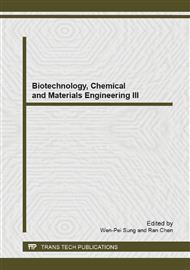p.516
p.522
p.526
p.531
p.535
p.540
p.544
p.548
p.553
Study on Hydrolysis Conditions of Lactobacillus bulgaricus on Casein Sodium by Method of Response Surface and the Antioxidant Activity of Hydrolysates
Abstract:
In order to study the ability of Lactobacillus bulgaricus hydrolyzed protein, using casein sodium as substrate, the content of free amino acid and relative ORAC value were used as the index optimization. The conditions including: hydrolysis temperature, cultivation time, Lactobacillus bulgaricus dosage and pH values were investigated by single-factor experiment. In this paper we studied the hydrolysis conditions of Lactobacillus bulgaricus on casein sodium by the Box-Behnken response surface and the optimal hydrolysis temperature, cultivation time, Lactobacillus bulgaricus dosage and pH value were determined to be 43 °C, 36 h, 25 OD/ml, and pH 6.6, respectively. The optimum value of response surface is 857.75 mg/l. In addition, the analysis of relative ORAC value of response surface showed that there is no direct relationship between the degree of protein hydrolysis and radical scavenging activity, namely as extensive hydrolysis could have a negative impact on the antioxidant activity.
Info:
Periodical:
Pages:
535-539
Citation:
Online since:
January 2014
Authors:
Keywords:
Price:
Сopyright:
© 2014 Trans Tech Publications Ltd. All Rights Reserved
Share:
Citation:


